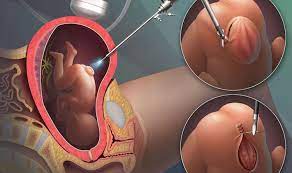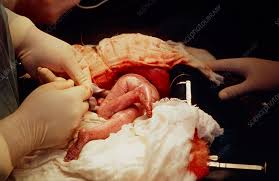…
 Fetal surgery is a branch of maternal-fetal medicine that covers any of a broad range of surgical techniques that are used to treat congenital abnormalities in fetuses who are still in the pregnant uterus.
Fetal surgery is a branch of maternal-fetal medicine that covers any of a broad range of surgical techniques that are used to treat congenital abnormalities in fetuses who are still in the pregnant uterus.
Fetal surgery also known as antenatal surgery, or prenatal surgery.
It covers any of a broad range of surgical techniques that are used to treat congenital abnormalities in fetuses who are still in the pregnant uterus.
There are three main types:
open fetal surgery, which involves completely opening the uterus to operate on the fetus;
minimally invasive fetoscopic surgery, which uses small incisions and is guided by fetoscopy and sonography;
percutaneous fetal therapy, which involves placing a catheter under continuous ultrasound guidance.
Most congenital conditions either do not require, or are not treatable through, fetal intervention.
Lesions that involve anatomical problems, for which in utero treatment is both feasible and can significantly improve the fetus’s continuing development and survival.
Fetal surgery draws principally from the fields of surgery, obstetrics and gynecology, and pediatrics- especially the subspecialties of neonatology, maternal-fetal medicine, and pediatric surgery.
Addressing anticipated concerns prior to birth increases the probability of a healthy baby, with few long-term health problems related to the treated condition.
Fetal intervention involves risk to fetus and to the pregnant patient.
Risks include that of general risks associated with any surgery, there is also a risk that scarring of the uterus will lead to difficulties with future pregnancies.
The risk of scar formation is higher than for a typical Cesarean section:
The incision is usually a classical vertical one, with a greater risk of complications in subsequent pregnancies
The longer duration of the surgery, while the fetal intervention is performed
A second surgery is required days or weeks later, with a Caesarean section to deliver the baby, which brings its own set of risks.
Open fetal surgery is similar in many respects to a normal cesarean section performed under general anesthesia, except that the fetus remains dependent on the placenta and is returned to the uterus.
Open fetal surgery consists of an interim procedure intended to allow the fetus to remain in utero until it has matured enough to survive delivery and neonatal surgical procedures.
Upon completion of the fetal surgery, the fetus is put back inside the uterus and the uterus and abdominal wall are closed up.
Before the last stitch is made in the uterine wall, the amniotic fluid is replaced.
Often babies who have been operated on in this manner are born pre-term.
Tocolytics are generally given to prevent labor.
Gastric acid inhibitors are used to reduce the risk of aspiration.
Rapid sequence induction is often used for sedation and intubation.
A hysterotomy is performed on the pregnant woman, and once the uterus is open and the fetus is exposed, the fetal surgery begins.
Fetal surgery is an interim procedure intended to allow the fetus to remain in utero until it has matured enough to survive delivery and neonatal surgical procedures.
After completion of the fetal surgery, the fetus is replaced into the uterus and the uterus and abdominal wall are closed.
Prior to the closing of the uterine wall, the amniotic fluid is replaced.
The mother is monitored in the hospital for 3–7 days postop.
Commonly babies who have been operated on in this manner are born pre-term.
The overall perinatal mortality after open surgery has been estimated to be approximately 6% in old studies.
The exact mortality rate of fetal surgery varies depending on the type of surgery and the underlying condition, as well as the skill and experience of the surgical team.
Studies have shown that the overall rate of fetal or neonatal mortality following fetal surgery is between 5 and 15 percent.
Fetal surgery goals: maternal safety, avoiding preterm labor and achieving the aims of the surgery.
Open fetal surgery is considered a possibility after approximately 18 weeks of gestation due to fetal size and fragility before that, and up to approximately 30 weeks of gestation due to increased risk of premature labor and, practically, the preference for delivering the child and performing the surgery in ex utero/pediatric surgery, instead.
The risk of premature labor is increased by concomitant risk factors: multiple gestation, a history of maternal smoking, and very young or old maternal ages.
Premature labor and delivery may occur as a result of fetal surgery and can increase the risk of mortality for the newborn.
Factors that contribute to the risk of fetal surgery mortality include the age and health of the mother, the size and position of the fetus, and the type and complexity of the procedure.
Open fetal surgery reasonably safe for the mother.
Fetal safety and effectiveness of surgery varies and depends on the specific procedure, the underlying pathology and the gestational age and condition of the fetus.
All future pregnancies for the mother require cesarean delivery because of the hysterotomy.
Indications: Neural tube defects (NTD), which begin to become observable at the 28th day of pregnancy.
Prenatal repair of the most easily treated NTD is myelomeningocele.
Children treated with open fetal repair have significantly improved outcomes compared to children whose defects are repaired shortly after birth: fetal repair reduces the rate of ventriculoperitoneal shunt dependence and Chiari malformation, while improving motor skills at 30 months of age compared to post-natal repair.
Children having fetal repair are twice as likely to walk independently at 30 months of age than children undergoing post-natal repair.
Open fetal repair of spina bifida is now considered standard of care at fetal specialty centers.
Other conditions that potentially are treated by open fetal surgery include:
Congenital diaphragmatic hernia-is now more likely to be treated by endoscopic fetal surgery.
Congenital cystic adenomatoid malformation
Congenital heart disease
Pulmonary sequestration
Sacrococcygeal teratoma
Minimally-invasive fetoscopic surgery
Twin-twin transfusion syndrome
Spina bifida – Fetoscopic closure of the malformation.
